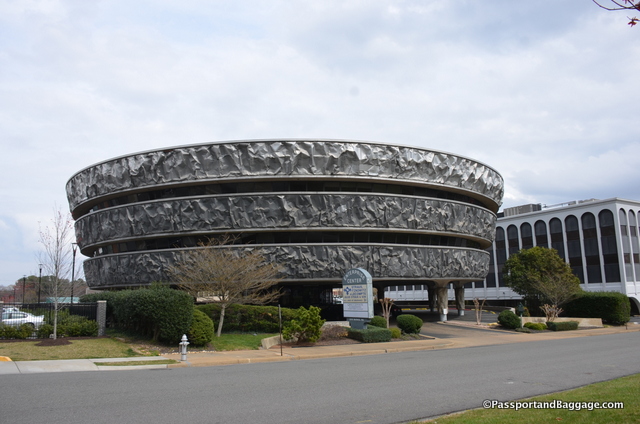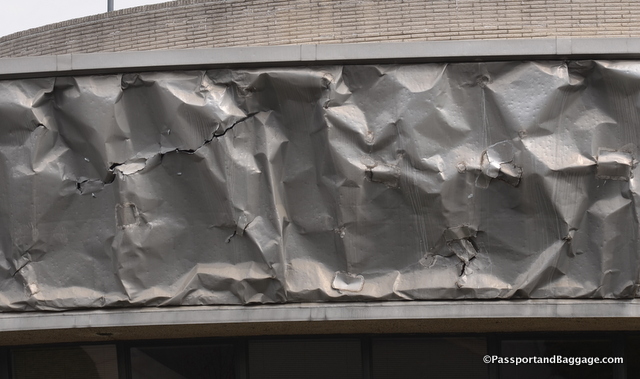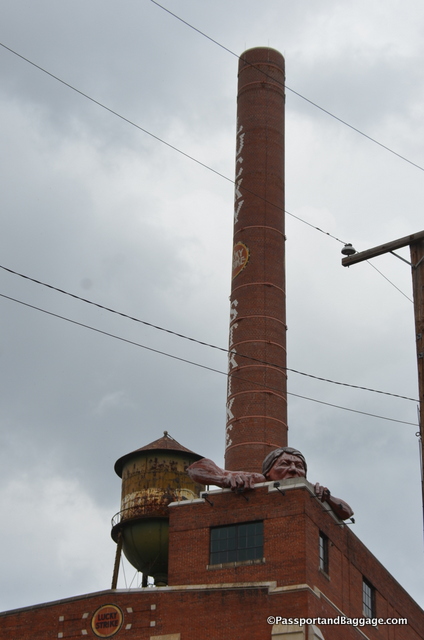There are always weird and wonderful things that one finds when traveling, and here are three that I found in Richmond.
The Markel Building
5310 Markel Road
This 1962 building by Haig Jamgochian, was inspired by a foil wrapped potato. Don’t believe me? Check out the historic marker sign next to the building.
As the sign says, each floor is one single piece of aluminum. Sadly this aluminum siding material is not holding up too well. Much of the texture was derived by Jamgochian using a sledgehammer to the aluminum, and much of that has been repaired in various ridiculous ways.
Haigh Jamgochian (1925- ) known as Jam to his friends, was born in Richmond, VA to Armenian immigrants fleeing to America to escape genocide in their country. He studied at Dartmouth, Virginia Tech and Princeton, and trained for a short time with Frank Lloyd Wright. He writes of the building: “They wanted it to be built a certain way but had a limited budget, so we took the weight out of the building to lower the cost. The idea to wrap a building in aluminum came to me over dinner one evening…”
The second unusual site is the Grand Kugel in front of the Union Station of Richmond which is now the Virginia Museum of Science at 2400 West Broad Street.
A kugel ball is a perfectly spherical stone ball that is set into a matching, perfectly concave cup. Water is then forced in from the bottom of the cup creating an evenly distributed, incredibly thin layer of water. The ball, almost no matter how heavy can then be moved on the liquid surface as though it weighed nothing at all.
A number of these floating stone spheres can be found around the globe, however, the Grand Kugel, installed in 2003, is the largest of these sculptural science experiments in the world. It is actually known as the Mary Morton Parsons Earth-Moon Sculpture, after its benefactor.
The third crazy stop is Connecticut The Indian at 2700 East Carey Street.
The sculpture is the work of Richmond artist Paul DiPasquale, who created the statue as a tribute to the area’s natives in 1983 with the intention of having it installed in Washington D.C. DiPasquale is also the sculptor of the Arthur Ashe sculpture on Monument Avenue.
“Connecticut” comes from the Eastern Algonquin Indian word, Quinnehtukgut which means beside the long tidal river.
The rooftop in the Shockoe Bottom neighborhood is the statue’s third home. Fabricated for the roof of a liquor store at 2600 Connecticut Avenue in Washington, D.C., a family dispute blocked the installation. Di Pasquale sought a new home and Frances and Sydney Lewis became interested who founded Best Products Company in Richmond in 1957, collectors of contemporary art.
Di Pasquale sought a new home and Frances and Sydney Lewis, collectors of contemporary art who founded Best Products Company in Richmond in 1957, became interested. However, local officials ruled that the statue was a sign and in violation of rooftop signage codes.
Bought back by the artist DiPasquale donated it to the Richmond Braves who placed it on top of a concession stand at “The Diamond”, the Triple-A baseball team’s new stadium, built in 1985. There he sat for nearly 25 years, as the mascot of the Braves. But in 2010, the Braves moved out of Richmond. Hopefully, as its final resting place, the sculpture was purchased by ODELL Architects and moved to the Lucky Strike power plant, an old tobacco factory complex that was being converted into loft apartments and offices. The easiest way to view Connecticut The Indian is down by the railroad tracks between Carey Street and the Canal.
Always remember to enjoy the sublime AND the ridiculous on your journey.




